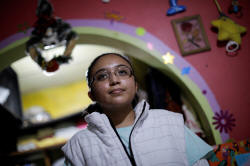|
Salazar's older sister, Perla, was born with a rare disorder
that affects mobility and hearing, called MERRF syndrome. The
25-year-old has undergone close to a dozen surgeries followed by
years of physical therapy, and was told by one sign language
school that she would be unable to learn to sign due to her
condition.
Salazar, whose academic prowess allowed her to graduate three
years early from high school, said that, after seeing the
discrimination Perla faced, she asked herself: "What am I doing
to help my sister?"
Last year, she started developing an application to connect
Mexican Sign Language (MSL) speakers with hearing users -
allowing people to shift from sign language to text or voice,
and vice versa.
An estimated 4.6 million Mexicans are deaf or hard-of-hearing,
according to Mexico's statistics agency. There is a chronic
shortage of certified MSL interpreters, though many Mexicans act
as unofficial interpreters for deaf or hard-of-hearing family
members.
Estrella formed a community of nearly 90 participants -
including native speakers and interpreters - to develop the app,
called Hands with Voice, which she hopes to launch this year. In
recent months, the family has started to learn sign as Perla's
mobility has improved.
"I'm proud of my sister," said Perla. "And I've liked finding a
community along the way."
In addition to juggling the app development and university
studies in biotechnology engineering, Salazar gives science
classes near her home in Nezahualcoyotl, 5 km (3 miles)
northeast of Mexico City.
"I think it's time to change the way people think," Salazar told
Reuters: "to be able to create a culture where, in the future,
there will be lots of children working on scientific and
technological projects."
Salazar's mother, Leticia Calderon, said she would take a young
Estrella to her sister's therapy sessions and noticed how
quickly she caught on. To practice Perla's speech, Calderon
would ask her daughter questions about what she was learning in
school.
"I would put (Estrella) in the highchair, and from there she
would tell her sister the answers to her exams," Calderon said.
Salazar's appetite for learning quickly outpaced what teachers
in Nezahualcoyotl could offer, she said. By the time she was 15,
Salazar passed her high school exams and was keen to start to
apply her knowledge.
Salazar was one of 60 young people chosen to attend the
International Air and Space Program, a five-day camp this spring
run by a NASA contractor in Huntsville, Alabama, home to the
Marshall Space Flight Center.
To cover the cost of the $3,500 camp, Salazar launched a
crowd-funding campaign on her Instagram account. With weeks left
to reach her goal, she says she's 75% there.
Now, Salazar said, she's on the hunt for a U.S. university that
will allow her to continue her investigation on the neurological
impacts of COVID-19, both during active infection and after
illness.
"I know young people, children, who have a way of thinking that
says: 'It doesn't matter where I come from, what matters is what
I'm going to do,'" Salazar said.
"I'm really proud to be from here, from Nezahualcoyotl, and to
see kids learning and giving it their all to accomplish what
they want to do."
(Reporting by Kylie Madry in Nezahualcoyotl, Mexico; Editing by
Lisa Shumaker)
[© 2022 Thomson Reuters. All rights
reserved. This material may not be published,
broadcast, rewritten or redistributed.
Thompson Reuters is solely responsible for this content.]

|
|





